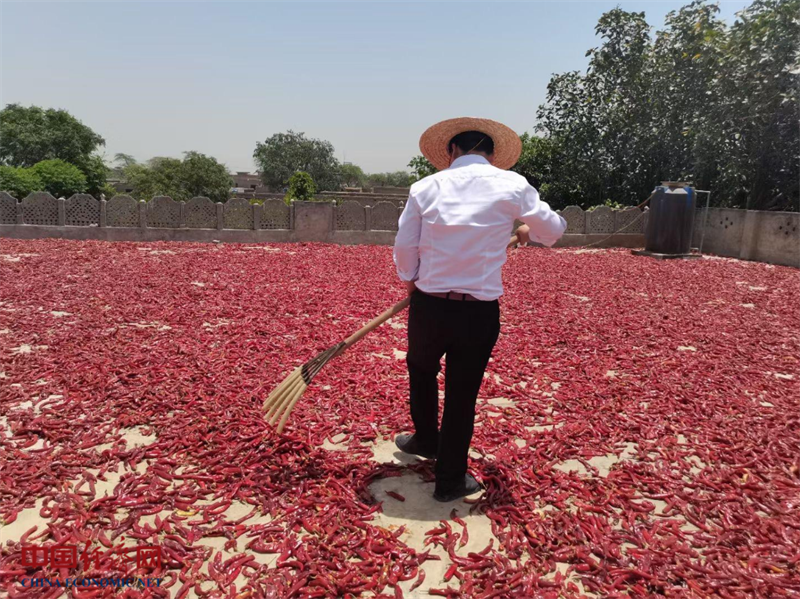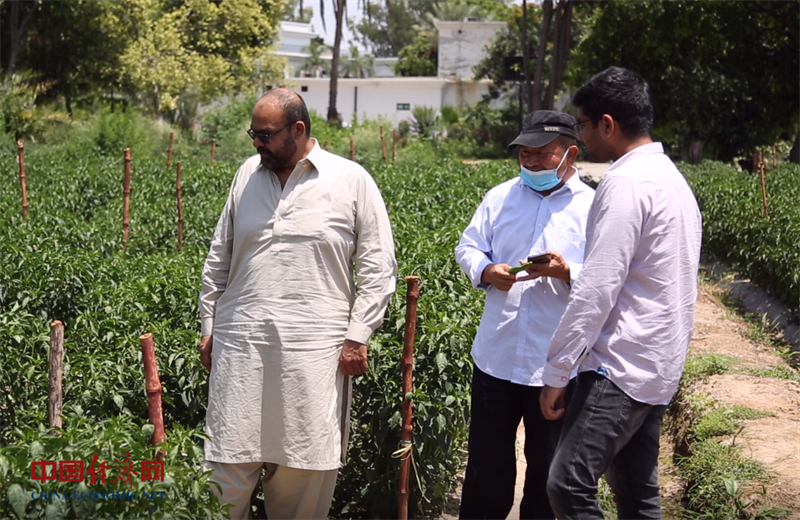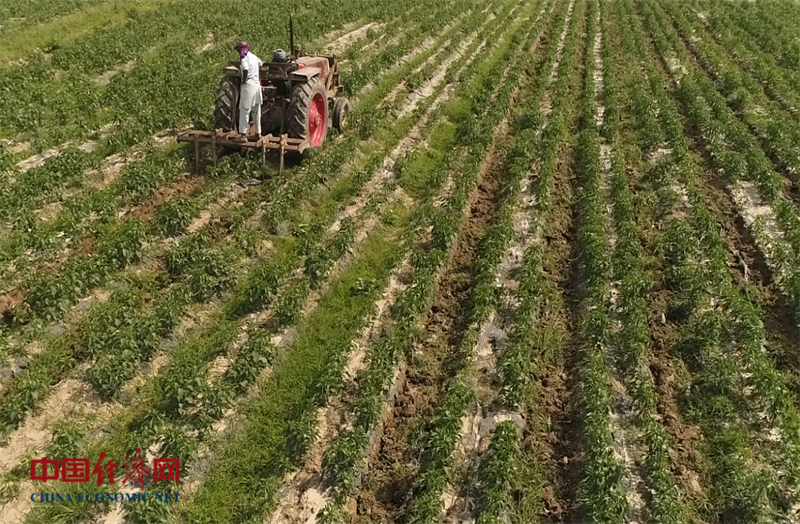Pakistani chilli to spice up China in August
By Liu Qiyu | China Economic Net Jul 13, 2021

300 tons of chilli will be dried and exported to China in August. [Photo/China Economic Net]
by Liu Qiyu
LAHORE, July 13 (China Economic Net) - Soaked in the summer sun, 300 tons of chilli glow softly in the pilot chilli field in Lahore, Punjab, Pakistan. “The 300 tons of chilli we picked will be dried and exported to China in August,” noted Wu Guang, General Manager of Pakistan Subsidiary, China Machinery Engineering Corporation (CMEC), adding that it is the first time Pakistani chilli enter the Chinese market since 2020.
What happened to Pakistani chilli?
Pakistan has ideal conditions for Chilli/Pepper (Capsicum Annum L.) cultivation. According to Food and Agriculture Organization of the United Nations (FAO), Pakistan is amongst the top ten chilli producing nations which enjoy a combination of warm, humid yet dry weather and a well-drained sandy loam with rich organic content.
However, Pakistan's chilli production has been lower than the world average for the same period since 2015. From FY2014–15 to FY2017-18, the average annual production of chilli in Pakistan was around 143,428 tons, but it plummeted to 126,943 tons in FY2018-19, accounting for 85.7% its peak in FY2017-18 of 148,114 tons.
Take Sindh as an example. In Pakistan, Sindh province is the major producer of chilli followed by Punjab and Balochistan. The major constraints in production faced by chilli farmers here are lack of modern irrigation system, imbalance use of fertilizer and pesticide, and lack of training.
“In Pakistan old methods of 1970s, 1960s or 1980s are adopted by farmers. Now Pakistan has to adopt modern technology to increase its production,” recommended Zahid Gishkori, a Special Investigative Correspondent in Pakistan.
What is worse, growers are troubled by some marketing issues, including unreasonable commission agent charges, improper weighing, price fluctuations and lack of proper storage facilities. Pepper growers are unable to make a proper profit from chilli due to marketing channel barriers.
Talking to China Economic Net, Khurum Javed Maqbool, Director Marketing of Fatima AG Soultions Limited, Pakistan, pointed out that at present the whole ecosystem in Pakistan is inefficient. “From harvesting to sewing and storing of the crop and then selling it and then farmers getting financing and then the returns for their produce... All these operations require improvement.”
China-Pakistan cooperation to heat up Pakistan’s chilli industry

Pakistani farmers and a Chinese agricultural expert in the field. [Photo/China Economic Net]
In July, a pilot Chilli farm project under the cooperation between Pakistani farmers and their Chinese partners - CMEC & Sichuan Litong Food Group - began to bear fruit, with a yield around 3 times Pakistani varieties.
Chen Changwei, Chairman of Sichuan Litong Food Group, China, noted that their pilot Chilli farm project successfully completed 100 acres of plantation in the first half of 2021 in Lahore. For the 100-acre-pilot-project, the quantities of seeds are 380 grams per acre, with a yield reaching 3 tons per acre. The total production is expected to reach 300 tons.
While as per Ministry of National Food Security & Research (Economic Wing), chilli is grown on 47,349 hectares in Pakistan with a crop yield of about 2.68 tons per hectare (1.072 tons per acre) and an annual production of around 126,943 tons in FY2018-19.
Why did the production up about 3 times with the same soil and farmers?
Seed matters. As per Chen, they brought a total of 13 varieties of Chinese chillies to Pakistan since 2019. It took them three years to conduct the pilot program, and of all these 13 varieties, two varieties, namely, PJH-302 and PJH-407, have been certified for cultivation in Pakistan.
“Seed is the basic input for agriculture sector and has imperative role in enhancing agriculture productivity, food security and poverty alleviation,” said YEAR BOOK 2019-20 released by Ministry of National Food Security and Research (NFS&R), Pakistan.
On top of seeds, field management is also of great significance. Correct and careful management of farming and farmers could increase efficiency and reduce risk.
“We’re gonna arrange a team of 3 agricultural experts on each chilli field of around 0.165 acres,” Wu Guang told China Economic Net. And these agricultural experts will train Pakistani staff in planting technology.
Advanced Chinese irrigation systems have also been introduced into the field. Umer Diyal, a farmer who worked in the pilot Chilli farm in Qasbi, Lahore, said that the Chinese introduced an irrigation system, and the expense of fertilizer has been reduced and every plant was getting water. “Watering of plants is not complex and expensive any more,” he added.
Also, contract farming helps a lot when it comes to addressing farmers’ concerns about marketing.
Agriculture-related economy is vulnerable, so “we’re conducting contract farming with Pakistani farmers,” Wu Guang told China Economic Net. That is, Pakistani farmers undertake to supply agreed quantities of chilli, based on the quality standards and delivery requirements of CMEC. In return, CMEC agrees to buy the chilli, at a price that is nailed down in advance.
“When the chillies are ripe, they are naturally dried and then shipped back to China for further processing,” Chen Changwei noted.
“If there is a farmer, who has harvested 100 acres of chilli crops in Nawabshah, Sindh, his profits from the local markets would be low. About 70% of the households in Pakistan grow on their own, so they wish to export the chilli to other countries,” Zahid Gishkori said, hinting that contract farming might be a feasible way for them to “export” at doorstep during the pandemic period.
“This model generates employment in the rural economy, reduces risk for firms, and provides income for farmers,” Wu Guang told China Economic Net. He further mentioned that in the next phase of the pilot Chilli farm project, as many as 3000 acres of land would be brought under chilli cultivation.
Chinese Ambassador to Pakistan Nong Rong praised the chilli farming project, saying that the project is expected to produce more than 8,000 tons of dried chillies with a net income of more than 100,000 rupees per acre for local farmers.
Lastly, Pakistan has another advantage over China in growing chillies. Sequential cropping is feasible here as the climate, soil, and water of Pakistan are different from that of China.
Chilli is a tropical and sub-tropical plant which requires warmer weather. Chen Changwei noted, the largest planting area of chilli in China is its northern part, which turns cold after September, so mostly chilli can only be planted for one season in China. While in Pakistan, “we can complete two seasons of planting as long as we avoid high temperatures from mid-June to August.”
“Our ultimate goal is to cooperate with our Pakistani friends on 200, 000 acres of land here,” Chen Changwei said determinedly.
Based on the planting, they will further develop downstream deep processing industries and create more employment opportunities in the future.
Little chillies, Great Expectations

For the 100-acre-pilot-project, the quantities of seeds are 380 grams per acre, with a yield reaching 3 tons per acre. [Photo/China Economic Net]
Wu Guang and Chen Changwei further shared with the reporter their three-step strategy.
Chen noted that in the first phase of Chilli Contract Farming Project, China-Pakistan Agricultural Cooperation Pilot Zone is to be set up in five years, forming an industrial belt from areas around Faisalabad, Multan, KPK and Lahore.
The second step is processing. A chilli processing plant will be established in Pakistan within 3 years to extract chilli pigment and chilli essence, with an industrial output value of USD 200 million.
While in the third phase, a China-Pakistan food industrial park would be established in 5 to 10 years to help Pakistan boost processed chilli exports in days to come. Wu explained, chilli is only the beginning and they are to plant more crops like garlic in Pakistan in days to come, so as to form a complete industrial chain to deep process raw material close by.
“Many Chinese enjoy chilli sauce that is made of chilli, beans, garlic and so on, and it would be easier and economical to export deep-processed chilli products like bottled chilli sauce than raw material,” Wu said.
“As the Chinese technical researchers are involved in it we are sure the project has high prospects,” Dr Muhammad Azeem Khan, Chairman of Pakistan Agricultural Research Council (PARC) told CEN reporter, adding that the processed chilli will be exported from Pakistan, generating revenue from foreign markets and upgrading industrial structure in Pakistan.
Syed Fakhar Imam, Federal Minister for National Food Security and Research, Pakistan, adding that bilateral cooperation will enhance agricultural output and improve quality, enabling Pakistani commodities to reach international markets.
As per Pakistan Bureau of Statistics (PBS), Pakistan in FY2019-2020 exported 1,825 tons of chilli, worth Rs. 581.3 million, accounting for 63.6% of its peak in FY2016-17 of 5,905 tons worth Rs. 914.3 million for the last 19 fiscal years. Mostly Pakistan’s chilli and chilli products are exported to Middle Eastern markets like Saudi Arabia.
As China became the world’s leading chilli and pepper consuming country, there is ample room for Pak-China cooperation. According to statistics released by General Administration of Customs of China, China imported 49,800 tons of chilli worth USD 34.002 million in 2020. However, China did not import any chilli or chilli products from Pakistan in 2020. And for the last 5 years, China has only imported limited processed chilli products from Pakistan worth USD 4,099 in 2018-2019.
Despite its low export volume, Pakistan's chilli has been well received in China. On Daraz, the leading online marketplace in South Asia, it takes you Rs. 398 to buy one Red Chilli Powder weighed 110g. But when you search for Pakistani chilli on JD.com, a Chinese e-commerce giant, you could find the same Red Chilli Powder exported from Pakistan. It costs you RMB 33.6 (≈Rs. 820) to buy one in China, which is twice the original price in Pakistan. “This red chilli powder is incredible! For curry cooking authentic spices counts a lot,” a Chinese netizen posted a comment for it.
“At present, Pakistani pepper has a limited market share in China. But we are very confident that we can achieve a yield from hundreds of tons to tens of thousands of tons as the Pak-China project on chilli succeeded!” Wu Guang expressed his confidence in Pakistani chilli’s future market share in China.
Information in this article comes from third party providers. This website does not provide explicit or implied warranty for such information and is not liable for any losses directly or indirectly caused by using such information.




